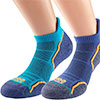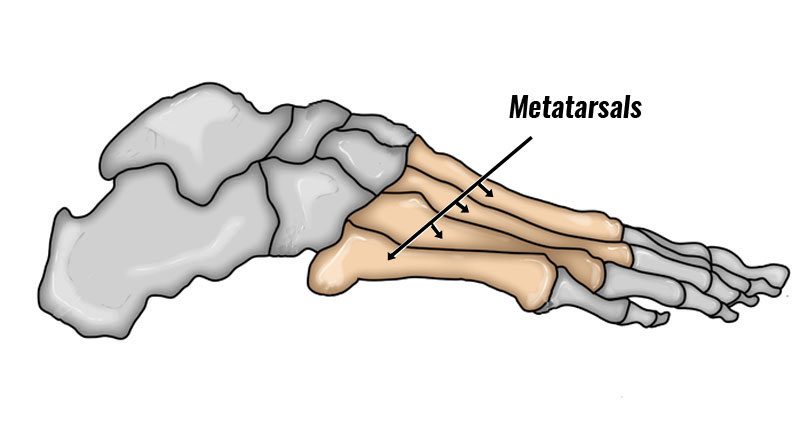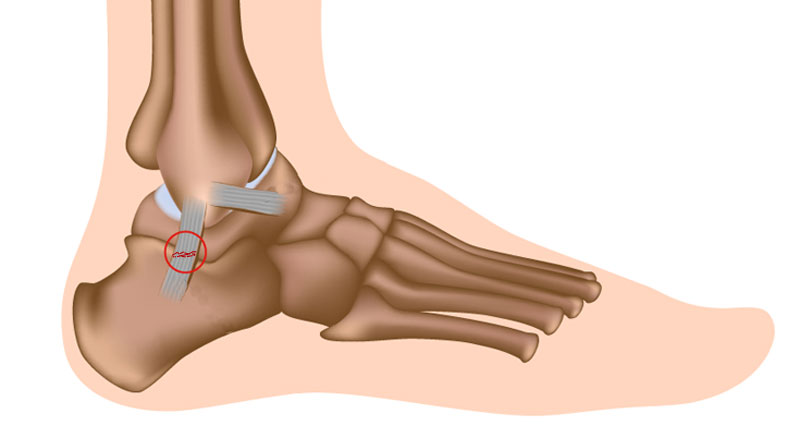A metatarsal fracture is a break to one of the five long metatarsal bones in the foot. It is often caused by direct trauma or impact to the top of the foot.
Medically reviewed by Dr. Chaminda Goonetilleke, 20th Jan. 2022
Symptoms
- Symptoms include acute and severe foot pain at the time of injury.
- There will likely be rapid swelling and the athlete will be unable to weight bear.
- Visibly deformity.
- Bruising will usually develop within 24 hours.
What is a Metatarsal fracture?
Metatarsals are the long bones in the forefoot. There are five in each foot, one leading up to each toe and forming the metatarsophalangeal joints otherwise known as the MTP joints.
Metatarsal fractures can be either an acute fracture or a stress fracture. A stress fracture develops gradualy through overuse.
Causes
Acute fractures result from direct impact impact or trauma, for example, being trodden on. Or dropping something on your toe.
Alternatively, a violent twisting or turning motion at the ankle may cause a fracture in the 5th metatarsal in particular.
Specific types of metatarsal fracture include an avulsion fracture, where the tendon of the peroneus brevis muscle pulls a piece of the bone away. Or a Jones fracture which occurs at the base of the 5th metatarsal. This typically has a poor blood supply. Therefore, affects healing.

Technical Running Socks
Treatment for Metatarsal fractures
See a Doctor as soon as possible who will X-ray the foot to confirm if there is a fracture and the type of fracture. If the bones are not displaced then a short cast or boot will be fitted for the first three weeks. After six weeks the foot should be X-rayed again to ensure it has healed.
More complex or displaced fractures may require surgical fixation. Jones fractures require 6-8 weeks of non-weight bearing immobilization. Once the cast has been removed, a thorough rehabilitation program should begin to regain full mobility and strength. A gradual return to sport can then begin.
Rehabilitation and exercises
Rehabilitation of a metatarsal fracture may begin at different stages, depending on whether it is an acute fracture or a stress fracture and also the extent and location of the injury.
Acute metatarsal fractures which require complete immobilization in a plaster cast should not have rehabilitation until after the cast is removed.
Ankle range of motion
Start by moving the ankle through its full range of motion, you can do this using ankle circles or by writing the alphabet with your toes! Try to practice doing this on a regular basis to help reduce stiffness and also to ease swelling and increase blood flow to the injury.
Toe range of motion
Point your toes up and then down as far as possible. Hold each position for a few seconds and then reverse. Try to spread your toes apart as far as possible and then to scrunch them up as well. Hold for a few seconds, before reversing the movement.
Calf stretches
It is common for the calf muscles to tighten up after an injury, especially if a period of immobilization or reduced weight bearing is required. Stretch both calf muscles regularly every day:
To stretch the Gastrocnemius, stand with a wide stance, with the leg to be stretched at the back. Keep the heel on the floor and the knee straight as you lean forward. When you feel a stretch in the calf, hold this position for 20-30 seconds. If the stretch fades in this time, then lean a little further forwards until you can feel it again.
To stretch the Soleus muscle, Stand with a narrower stance, still with the leg to be stretched at the back and the heel down. This time, bend both knees as if trying to squat down, you should feel a stretch lower down the calf, around the Achilles tendon. Again hold for 20-30 seconds and maintain that stretching feeling.
Repeat both stretches 2-3 times and several times a day.
Strengthening exercises
Strengthening exercises should focus on building the strength of the intrinsic muscles of the foot, which attach to the metatarsal bones. Other activities which can strengthen these muscle include walking on sand or other uneven surfaces.
Towel pull
Place a small, lightweight towel on the floor, laid out in front of you. Sit on a chair with the feet flat on the towel making sure there is plenty of towel in front of you to pull. Use the toes to pull the towel towards you, bit by bit. Keep the heel on the floor. Once you find this easy, it can be progressed by using a heavier towel or even adding a small weight to the end of the towel.
Pencil pick-up
In a seated position, place a pencil on the floor just in front of you. Pick the pencil up using your toes. Hold it for a few seconds and repeat this 10 times.
Walking on tip toes
Rise up on to your tiptoe. Walk forwards slowly, always controlling your balance before you take your next step. Start off walking 10-15 steps and gradually increase the distance.
Single leg balance
Start off by trying to balance on the injured leg only. Make sure you have something to hold on to in case you lose balance. Once you can master 30 seconds unaided, move on.
Wobble board balance
Use a wobble board to initially practice balancing on both feet. Once you find this easy, move on to the injured leg alone. You can further challenge your balance by adding in other movements such as rotating the upper body, raising the arms up and down or even closing your eyes!










